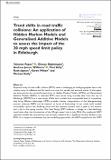Files in this item
Trend shifts in road traffic collisions : an application of Hidden Markov Models and generalised additive models to assess the impact of the 20mph speed limit policy in Edinburgh
Item metadata
| dc.contributor.author | Popov, Valentin | |
| dc.contributor.author | Nightingale, Glenna | |
| dc.contributor.author | Williams, Andrew James | |
| dc.contributor.author | Kelly, Paul | |
| dc.contributor.author | Jepson, Ruth | |
| dc.contributor.author | Milton, Karen | |
| dc.contributor.author | Kelly, Michael | |
| dc.date.accessioned | 2021-01-25T15:30:01Z | |
| dc.date.available | 2021-01-25T15:30:01Z | |
| dc.date.issued | 2021-01-11 | |
| dc.identifier | 271694068 | |
| dc.identifier | 3cd4a088-104d-4554-8a26-639af721c9dc | |
| dc.identifier | 85099294695 | |
| dc.identifier | 000626209900001 | |
| dc.identifier.citation | Popov , V , Nightingale , G , Williams , A J , Kelly , P , Jepson , R , Milton , K & Kelly , M 2021 , ' Trend shifts in road traffic collisions : an application of Hidden Markov Models and generalised additive models to assess the impact of the 20mph speed limit policy in Edinburgh ' , Environment and Planning B: Planning and Design , vol. OnlineFirst . https://doi.org/10.1177/2399808320985524 | en |
| dc.identifier.issn | 0265-8135 | |
| dc.identifier.other | ORCID: /0000-0002-2175-8836/work/87846076 | |
| dc.identifier.uri | https://hdl.handle.net/10023/21320 | |
| dc.description.abstract | Empirical study of road traffic collision (RTCs) rates is challenging at small geographies due to the relative rarity of collisions and the need to account for secular and seasonal trends. In this paper, we demonstrate the successful application of Hidden Markov Models (HMMs) and Generalised Additive Models (GAMs) to describe RTCs time series using monthly data from the city of Edinburgh (STATS19) as a case study. While both models have comparable level of complexity, they bring different advantages. HMMs provide a better interpretation of the data-generating process, whereas GAMs can be superior in terms of forecasting. In our study, both models successfully capture the declining trend and the seasonal pattern with a peak in the autumn and a dip in the spring months. Our best fitting HMM indicates a change in a fast-declining-trend state after the introduction of the 20 mph speed limit in July 2016. Our preferred GAM explicitly models this intervention and provides evidence for a significant further decline in the RTCs. In a comparison between the two modelling approaches, the GAM outperforms the HMM in out-of-sample forecasting of the RTCs for 2018. The application of HMMs and GAMs to routinely collected data such as the road traffic data may be beneficial to evaluations of interventions and policies, especially natural experiments, that seek to impact traffic collision rates. | |
| dc.format.extent | 17 | |
| dc.format.extent | 691120 | |
| dc.language.iso | eng | |
| dc.relation.ispartof | Environment and Planning B: Planning and Design | en |
| dc.subject | Road traffic collisions | en |
| dc.subject | Speed limits | en |
| dc.subject | Time series | en |
| dc.subject | State-space models | en |
| dc.subject | Trend shifts | en |
| dc.subject | QA Mathematics | en |
| dc.subject | 3rd-DAS | en |
| dc.subject.lcc | QA | en |
| dc.title | Trend shifts in road traffic collisions : an application of Hidden Markov Models and generalised additive models to assess the impact of the 20mph speed limit policy in Edinburgh | en |
| dc.type | Journal article | en |
| dc.contributor.institution | University of St Andrews. Centre for Research into Ecological & Environmental Modelling | en |
| dc.contributor.institution | University of St Andrews. Statistics | en |
| dc.contributor.institution | University of St Andrews. Population and Behavioural Science Division | en |
| dc.contributor.institution | University of St Andrews. School of Medicine | en |
| dc.identifier.doi | https://doi.org/10.1177/2399808320985524 | |
| dc.description.status | Peer reviewed | en |
This item appears in the following Collection(s)
Items in the St Andrews Research Repository are protected by copyright, with all rights reserved, unless otherwise indicated.

